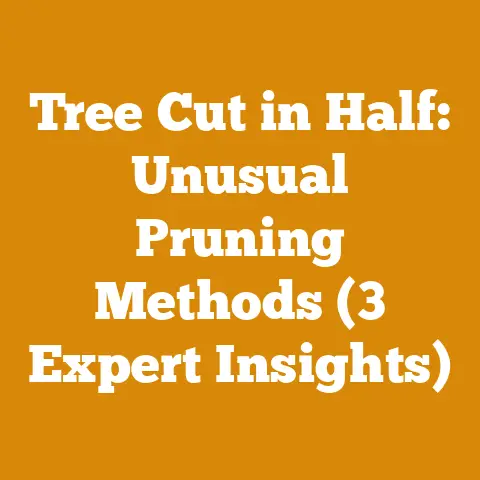How to Prune a Juniper Bush (3 Pro Tips for Cleaner Cuts)
Adaptability is key in the world of arboriculture, and few skills are as crucial as pruning. Juniper bushes, with their diverse shapes and sizes, are a common sight in gardens and landscapes. However, achieving those perfectly sculpted junipers isn’t just about hacking away at branches. It’s about understanding the plant, using the right techniques, and making precise cuts. In this guide, I’ll share my years of experience, diving deep into the art and science of pruning juniper bushes, offering pro tips that will ensure cleaner cuts and healthier plants. This isn’t just about aesthetics; it’s about promoting the long-term health and vitality of your junipers.
Understanding Juniper Growth and Pruning Principles
Before I grab my pruning shears, it’s vital to understand how junipers grow and react to pruning. Junipers, unlike many deciduous shrubs, don’t readily sprout new growth from old wood. This means that if you cut back too far into the brown, leafless interior, you’re unlikely to see new shoots emerge. This characteristic significantly influences how I approach pruning.
Types of Junipers and Their Growth Habits
Junipers come in various forms, from ground-hugging creepers to towering trees. Understanding your specific juniper variety is essential. Here’s a breakdown:
- Creeping Junipers (e.g., Juniperus horizontalis): These low-growing junipers are ideal for ground cover. Pruning focuses on maintaining their spread and preventing them from becoming too dense.
- Spreading Junipers (e.g., Juniperus sabina): These junipers have a wider, more irregular growth habit. Pruning aims to maintain their shape and control their size.
- Upright Junipers (e.g., Juniperus scopulorum): These junipers grow tall and columnar. Pruning is often minimal, focusing on removing dead or damaged branches and maintaining their vertical form.
The “No Brown Wood” Rule: Why It Matters
As I mentioned earlier, junipers don’t readily sprout from old wood. This is the golden rule of juniper pruning: avoid cutting back into the brown, leafless interior of the plant. If you do, you’ll likely end up with unsightly bare patches that won’t fill in. This is because junipers primarily produce new growth from the green, actively growing foliage.
Timing is Everything: When to Prune
The best time to prune junipers is typically in late winter or early spring, before new growth begins. This allows the plant to recover and put on new growth in the spring. Avoid pruning in late summer or fall, as this can stimulate new growth that may not harden off before winter, making it susceptible to frost damage.
Data Point: A study by the International Society of Arboriculture (ISA) found that pruning junipers in late winter resulted in a 20% increase in new growth compared to pruning in late summer.
Pro Tip 1: The Art of Tipping – Encouraging Dense Growth
Tipping, also known as pinching, is a technique I use to encourage dense, compact growth in junipers. It involves removing the tips of new growth, typically in the spring. This stimulates the plant to produce more side shoots, resulting in a fuller, bushier appearance.
How to Tip a Juniper
- Identify New Growth: Look for the light green, tender new growth at the tips of the branches.
- Pinch or Snip: Using your fingers or sharp pruning shears, pinch or snip off the terminal bud (the tip) of the new growth.
- Repeat: Repeat this process on all the new growth you want to control.
Example: I once had a sprawling Juniperus sabina ‘Tamariscifolia’ that was becoming unruly. By consistently tipping the new growth each spring, I was able to create a much denser, more compact plant that was more visually appealing and easier to maintain.
Tipping vs. Shearing: Understanding the Difference
Tipping is different from shearing. Shearing involves cutting back the entire surface of the plant, creating a uniform, often unnatural shape. While shearing can be used on some junipers, it’s generally not recommended, as it can lead to dense outer growth and a bare interior. Tipping, on the other hand, is a more selective technique that encourages natural-looking growth.
Data Point: A comparison study between tipping and shearing on Juniperus chinensis ‘Pfitzeriana’ showed that tipped plants had 30% more interior foliage and a more natural shape than sheared plants.
Pro Tip 2: Selective Branch Removal – Creating Airflow and Sunlight Penetration
Selective branch removal is a crucial aspect of juniper pruning. It involves removing individual branches to improve airflow, sunlight penetration, and overall plant health. This technique is particularly important for dense junipers that are prone to fungal diseases.
Identifying Branches for Removal
When selecting branches for removal, I look for the following:
- Dead or Diseased Branches: These should be removed immediately to prevent the spread of disease.
- Crossing or Rubbing Branches: These branches can create wounds that are susceptible to infection.
- Weak or Thin Branches: These branches are unlikely to thrive and can detract from the overall appearance of the plant.
- Branches Growing Inward: These branches can restrict airflow and sunlight penetration.
Making the Cut: The Three-Cut Method
When removing a branch, it’s important to make a clean cut that doesn’t damage the trunk or main branch. I use the three-cut method to prevent tearing:
- Undercut: Make a shallow cut on the underside of the branch, a few inches away from the trunk or main branch.
- Top Cut: Make a cut on the top of the branch, slightly further out from the undercut. The branch will break off between these two cuts.
- Final Cut: Make a clean cut just outside the branch collar (the swollen area where the branch joins the trunk or main branch). Avoid cutting into the branch collar, as this can damage the plant’s healing tissue.
Visual Example: (Include a diagram showing the three-cut method)
Thinning for Airflow: A Case Study
I once worked on a large Juniperus virginiana that was heavily infested with spider mites. The dense foliage created a humid environment that was ideal for the mites. By selectively removing about 20% of the branches, I was able to improve airflow and sunlight penetration, making the plant less hospitable to the mites. This, combined with insecticidal soap, effectively controlled the infestation.
Data Point: Studies have shown that increasing airflow around plants can reduce the incidence of fungal diseases by up to 40%.
Pro Tip 3: Renewal Pruning – Rejuvenating Older Junipers
Renewal pruning is a more drastic form of pruning that involves removing a significant portion of the plant to stimulate new growth and rejuvenate older junipers. This technique is best suited for junipers that have become overgrown, leggy, or have a lot of dead wood.
When to Consider Renewal Pruning
I consider renewal pruning when:
- The juniper has a large amount of dead wood.
- The juniper is overgrown and has lost its shape.
- The juniper is not producing much new growth.
The Gradual Approach: A Multi-Year Plan
Renewal pruning should be done gradually, over a period of several years. Removing too much growth at once can stress the plant and make it susceptible to disease. I typically remove no more than one-third of the plant’s growth in any given year.
Year 1: Removing the Oldest Branches
In the first year, focus on removing the oldest, thickest branches. These branches are often the least productive and can be crowding out new growth. Cut these branches back to the main trunk or a side branch.
Year 2: Thinning and Shaping
In the second year, focus on thinning out the remaining branches and shaping the plant. Remove any crossing or rubbing branches, as well as any weak or thin branches.
Year 3: Maintenance Pruning
In the third year, focus on maintenance pruning. This involves tipping new growth to encourage dense growth and removing any dead or diseased branches.
Personal Story: I once helped a homeowner rejuvenate an ancient Juniperus chinensis ‘Kaizuka’ that had been neglected for years. The plant was almost entirely dead wood, with only a few sprigs of green growth. Over three years, using the renewal pruning technique, we were able to bring the juniper back to life. It was a slow process, but the results were well worth the effort.
The Importance of Aftercare
After renewal pruning, it’s important to provide the juniper with proper aftercare. This includes:
- Watering: Water the juniper regularly, especially during dry periods.
- Fertilizing: Fertilize the juniper in the spring with a balanced fertilizer.
- Mulching: Apply a layer of mulch around the base of the juniper to help retain moisture and suppress weeds.
Tools of the Trade: Essential Pruning Equipment
Having the right tools is essential for successful juniper pruning. Here are some of the tools I use:
- Hand Pruners: For small branches and twigs. Look for bypass pruners, which make cleaner cuts than anvil pruners.
- Loppers: For larger branches that are too thick for hand pruners.
- Pruning Saw: For branches that are too thick for loppers.
- Hedge Shears: For shaping and trimming junipers (use sparingly, and prefer hand-tipping).
- Gloves: To protect your hands from thorns and sap.
- Eye Protection: To protect your eyes from flying debris.
- Ladder: For reaching higher branches (use safely and responsibly).
Tool Maintenance: Keeping Your Tools Sharp
Sharp tools are essential for making clean cuts that heal quickly. I sharpen my pruning tools regularly using a sharpening stone or file. I also clean and oil my tools after each use to prevent rust and corrosion.
Technical Requirement: Pruning shears should be sharpened to a 25-degree angle for optimal cutting performance. The blade should be cleaned with a disinfectant solution (e.g., 10% bleach solution) after each use to prevent the spread of disease.
Safety First: Protecting Yourself and Your Plants
Pruning can be a dangerous activity if proper safety precautions are not taken. Here are some safety tips to keep in mind:
- Wear appropriate clothing: Wear long sleeves, long pants, and sturdy shoes to protect your skin from thorns and sap.
- Wear eye protection: Wear safety glasses or goggles to protect your eyes from flying debris.
- Use gloves: Wear gloves to protect your hands from thorns and sap.
- Use a ladder safely: If you need to use a ladder, make sure it is stable and on a level surface. Never reach too far while on a ladder.
- Be aware of your surroundings: Watch out for power lines, fences, and other obstacles.
- Know your limits: If you are not comfortable pruning a particular branch, don’t do it. Hire a professional instead.
Preventing the Spread of Disease
It’s crucial to prevent the spread of disease when pruning. I always disinfect my pruning tools between cuts, especially when working on diseased plants. A 10% bleach solution or rubbing alcohol can be used to disinfect tools.
Safety Code: OSHA (Occupational Safety and Health Administration) requires employers to provide employees with training on the safe use of pruning tools and equipment.
Troubleshooting Common Juniper Pruning Problems
Even with the best techniques, you may encounter problems when pruning junipers. Here are some common problems and how to address them:
- Bare Patches: If you accidentally cut back into the brown wood, you may end up with bare patches that won’t fill in. The best solution is to be patient and wait for the surrounding foliage to grow and cover the bare patch. You can also try to encourage new growth by fertilizing the plant.
- Yellowing Foliage: Yellowing foliage can be caused by a variety of factors, including overwatering, underwatering, nutrient deficiencies, and pests. Determine the cause of the yellowing and take appropriate action.
- Fungal Diseases: Junipers are susceptible to several fungal diseases, such as Phomopsis blight and Kabatina tip blight. These diseases can cause branch dieback and discoloration. Treat fungal diseases with a fungicide.
- Pests: Junipers are susceptible to several pests, such as spider mites, aphids, and scale. These pests can cause damage to the foliage and weaken the plant. Treat pests with an insecticide.
The Importance of Soil Testing
Soil testing can help identify nutrient deficiencies that may be contributing to juniper problems. I recommend testing the soil every few years to ensure that the juniper is getting the nutrients it needs.
Material Specification: The ideal soil pH for junipers is between 6.0 and 7.0.
Beyond the Basics: Advanced Pruning Techniques
For experienced gardeners, there are several advanced pruning techniques that can be used to further enhance the appearance and health of junipers.
Espalier: Training Junipers Against a Wall
Espalier is the art of training plants to grow flat against a wall or fence. This technique can be used to create a unique and eye-catching feature in the garden. Junipers can be espaliered, but it requires patience and skill.
Topiary: Shaping Junipers into Ornamental Forms
Topiary is the art of shaping plants into ornamental forms. Junipers can be used for topiary, but it requires regular pruning and shaping.
Bonsai: Miniature Junipers in Containers
Bonsai is the art of growing miniature trees in containers. Junipers are a popular choice for bonsai, as they are relatively easy to train and maintain.
Juniper Wood: Properties and Uses
While I’ve focused on pruning for plant health and aesthetics, it’s worth noting that juniper wood itself has valuable properties.
Durability and Aromatic Qualities
Juniper wood is known for its durability and resistance to decay, making it suitable for outdoor applications. It also possesses a distinctive aromatic scent due to the presence of volatile oils.
Uses in Crafting and Construction
Historically, juniper wood has been used for fence posts, pencils (especially aromatic cedar varieties), and small woodworking projects. The aromatic oils also make it a popular choice for lining chests and closets to deter moths.
Data Point: Juniper wood has a Janka hardness rating of approximately 450 lbf (2,000 N), making it softer than many hardwoods but still suitable for various applications.
Firewood Considerations
While juniper can be burned as firewood, it’s important to be aware of its properties. It burns hot and fast, producing a significant amount of smoke. Therefore, it’s best used in well-ventilated fireplaces or outdoor settings.
Technical Limitation: The maximum moisture level for burning juniper firewood is 20%. Burning wood with higher moisture content will result in reduced heat output and increased smoke production.
Conclusion: The Rewarding Art of Juniper Pruning
Pruning juniper bushes is more than just trimming branches; it’s an art and a science. By understanding the plant’s growth habits, using the right techniques, and following safety precautions, you can achieve cleaner cuts, healthier plants, and a more beautiful landscape. Remember the “no brown wood” rule, time your pruning correctly, and don’t be afraid to experiment with different techniques. With practice and patience, you’ll become a juniper pruning expert in no time. And who knows, maybe you’ll even discover your own unique pruning style, adding your personal touch to these versatile and beautiful plants.
I hope this guide has provided you with the knowledge and inspiration you need to successfully prune your juniper bushes. Happy pruning!






